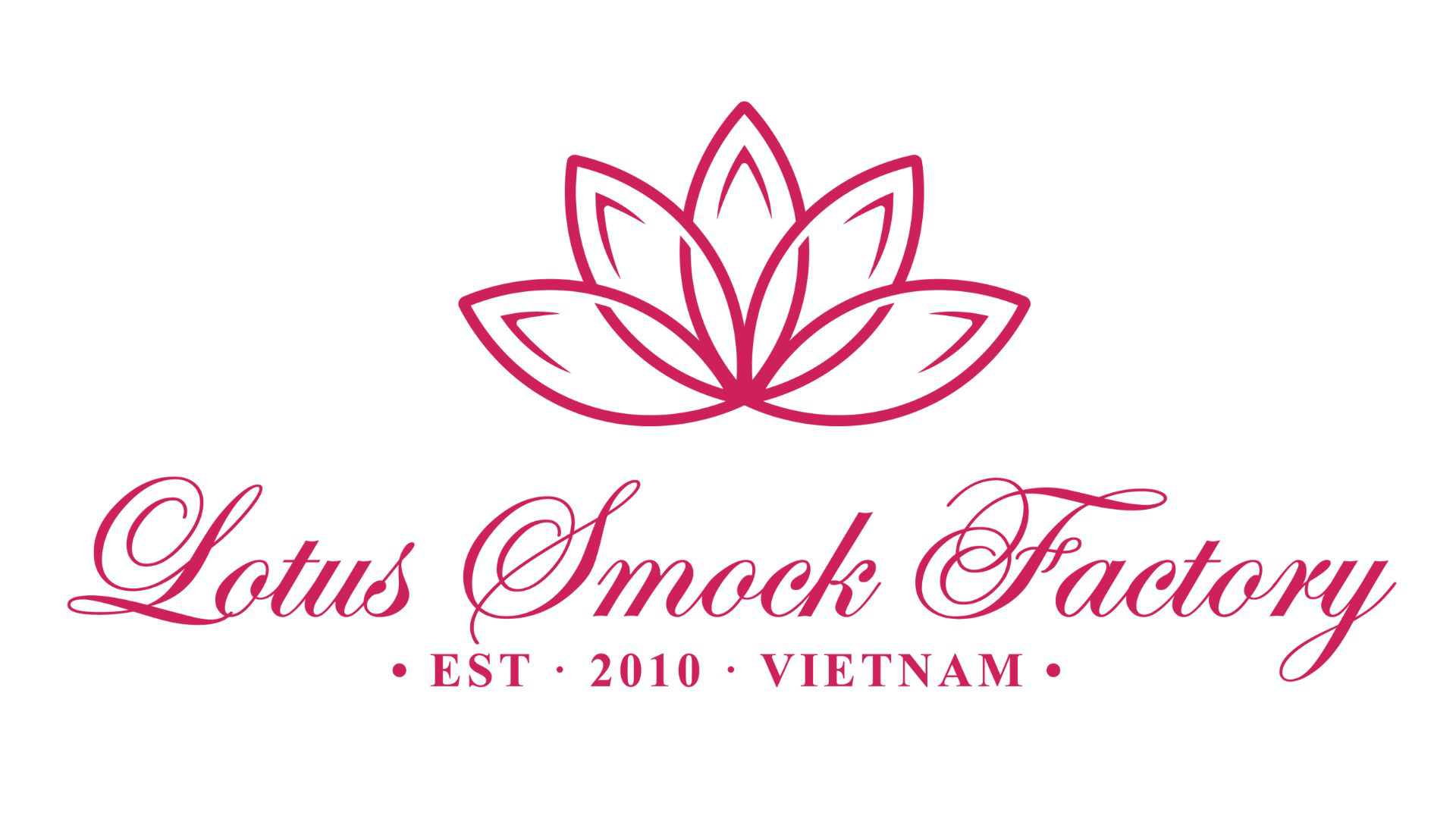How to Embroider Hats: A Complete Guide for Beginners
How to embroider hats? The answer is simple: you stitch designs, letters, or motifs onto caps, beanies, or bucket hats by hand or with a machine. Hat embroidery lets you add monograms, floral details, or logos without replacing the whole item. But beginners often struggle with curved surfaces, thick seams, and fabric that shifts during stitching. With the right tools, stabilisers, and steps, you can solve these problems.
In this guide, you will learn how to embroider hats by hand or machine, avoid common mistakes, and explore creative designs that make your hats stand out. Keep reading and try your first project today.
1. Why Embroider Hats?
When you know how to embroider hats, you can easily personalise everyday fashion that suits your style. A plain cap, beanie, or bucket hat becomes more meaningful when you add designs, initials, or motifs.
- Affordable customisation
You can add embroidery to a hat without buying new accessories. A few threads and a needle are enough to refresh an old hat. - Flexible designs
Hat embroidery works for many styles. You can stitch monograms, floral embroidery, or logos. Small motifs on the side or brim give a subtle look, while larger patterns on the crown stand out. - Value for sellers
For boutique owners or Etsy sellers, embroidered hats increase product value. Personalised designs can attract buyers who want something handmade. - Beginner-friendly project
Once you know the steps, hat embroidery is easier than it looks. It lets beginners practice on a small surface before moving to bigger projects like jackets or bags.
Expert Tip: We recommend that you start embroidering on small parts. Embroider a cuff or side panel first, then work on the front center of a cap when you feel more confident.
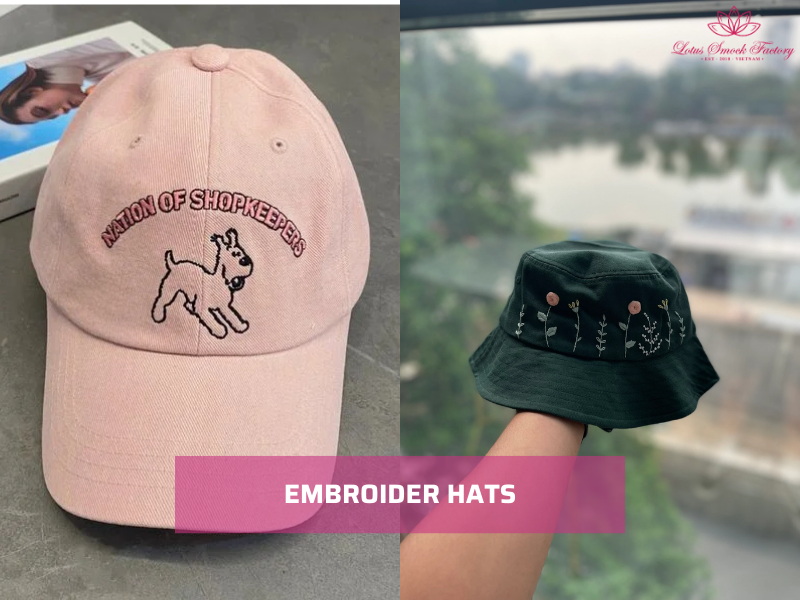
2. The Difference of Hand vs Machine Embroidery
Both methods can be used when learning how to embroider hats, but they produce different results. The table below shows the main differences.
| Feature | Hand Embroidery | Machine Embroidery |
| Speed | Slow. Each stitch is made by hand. | Fast. Can complete large or repeated designs quickly. |
| Detail | Delicate and flexible. Good for small motifs, curves, and colour blending. | Less detail. Some designs may look jagged or blocky. |
| Look & Feel | Soft, textured, and artistic. Each hat looks slightly different. | Smooth and uniform. Every hat looks the same. |
| Effort & Time | Time-consuming. Suitable for small projects or personal gifts. | Efficient. Works better for bulk orders or business use. |
| Tools Needed | Needle, thread, stabiliser, and hoop. Low cost to start. | Embroidery machine, hat hoop, and software. Higher cost. |
Summary: Hand embroidery is best for personal projects, artistic detail, or one-off hats. In contrast, machine embroidery works better for sellers who need speed, uniformity, and bulk production.
3. Tools & Materials You Need for Hat Embroidery
Before you start learning how to embroider hats, prepare the right tools. Using the correct needles, threads, and stabilisers will make your work easier and your designs last longer. Here is what you should prepare.
3.1. Needles & Threads
The right needle and thread will help you stitch neatly on curved hat surfaces and through thicker seams. Here are the details:
- Hand embroidery needles: Use sizes 5–9. Keep at least 3–5 needles on hand since tips may bend or dull when working through thick seams.
- Machine embroidery needles: Use size 75/11 ballpoint needles for knit beanies and size 90/14 denim needles for caps or structured hats. Keep a pack of 5 needles for replacements.
- Embroidery floss (cotton): Buy 3–5 skeins (8 m each) in different colours. For detailed designs, split into 2–3 strands. For bold lines, use the full 6 strands.
- Polyester embroidery thread (machine use): One 500 m spool is enough for several hats. Choose strong thread that resists breaking and fading.
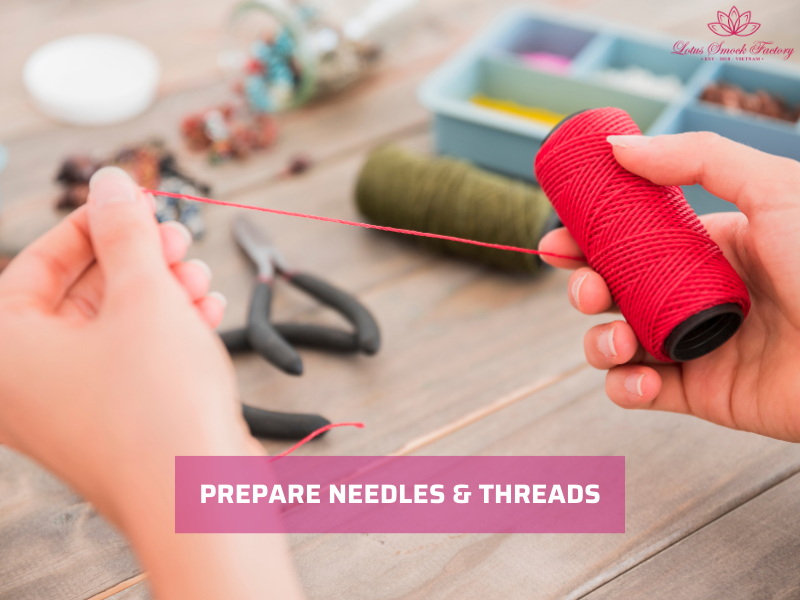
3.2. Stabilisers & Hoops
Stabiliser and hooping will support the fabric while you stitch, keeping the design straight and preventing wrinkles.
Cut-away stabiliser: Use 20 x 20 cm pieces for each embroidery area on stretch fabrics like beanies. One roll (25–30 sheets) covers multiple projects.
Tear-away stabiliser: Prepare 20 x 20 cm pieces for baseball caps or structured hats. One pack of 25 sheets works for practice and final designs.
Hoops:
- For hand embroidery: A 10–12 cm wooden or plastic hoop is enough for most hat areas.
- For machine embroidery: A special hat hoop is recommended. If unavailable, prepare a DIY hoopless setup with strong stabiliser.
3.3. Other Essentials
Moreover, you should prepare other materials and tools. These accessories help you mark designs, cut threads cleanly, and push needles through thick layers.
- Fabric marker or chalk: Keep 1 water-soluble marker or 1 chalk pencil. These wash off easily and won’t stain fabric.
- Small sharp scissors: Use embroidery scissors with curved tips (10–12 cm). One pair is enough, but having a backup saves time.
- Thimble: One metal or leather thimble is useful for thick areas, especially when working by hand on seams or brims.
4. How to Embroider Hats by Hand (Step-by-Step)
Hand embroidery on hats may look challenging because of the curved surface, but with the right approach, it becomes manageable. Follow these four steps to prepare your hat, add stitches, and finish neatly.
4.1 Step 1: Prepare the Hat
First, you start by preparing the surface.
- Wash and iron the hat if the material allows. This removes dirt and makes the fabric smoother for stitching.
- Mark your design with chalk or a water-soluble pen. Keep designs small at first, such as initials or a floral accent. Place marks on side panels or the cuff of a beanie, since these are easier to reach than the front center of a cap.
Preparing well saves you time later and reduces mistakes.
4.2. Step 2: Secure the Fabric
Because hats are round, keeping the fabric steady is the main challenge.
- For bucket hats or beanies, place the fabric area into a 10–12 cm embroidery hoop. This gives you a flat surface and even tension.
- For caps or structured hats, a hoop often does not fit. Instead, hold the fabric taut with your hand and add a piece of stabiliser behind the design area. Cut a square of stabiliser about 20 x 20 cm so it supports the stitches without shifting.
This step helps prevent puckering and makes stitches look even.
4.3. Step 3: Start with Basic Stitches
Once the fabric is secure, begin with simple stitches.
- Backstitch: Best for outlines, letters, or borders. Bring the needle up, make a stitch backward, and continue along the design.
- Satin stitch: Perfect for filling shapes like petals or bold initials. Work side-by-side stitches until the area is covered.
- French knots: Add small raised dots for accents such as flower centers or polka dots. Wrap the thread around the needle once or twice before pulling through the fabric.
Tips: Work with shorter thread lengths (30–40 cm) to avoid tangling. If you use embroidery floss, split it into 2–3 strands for thin lines or use the full 6 strands for bold work.
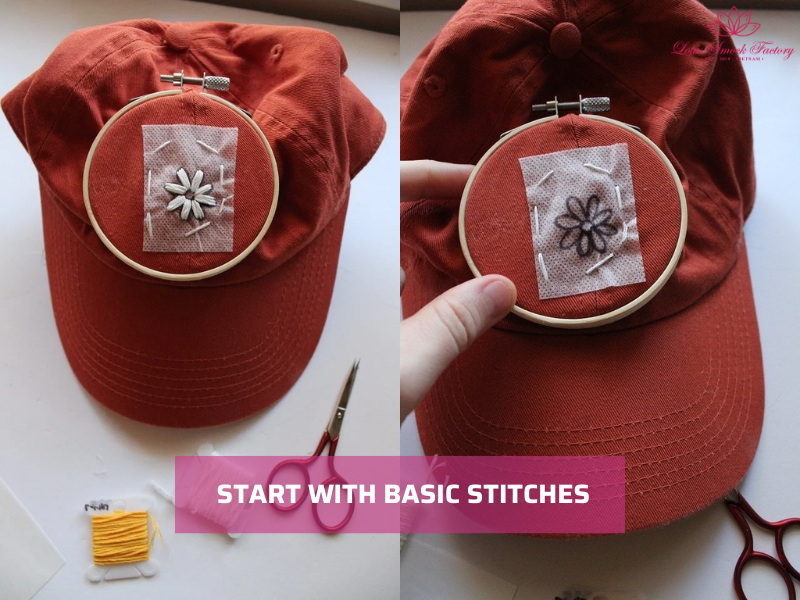
4.4. Step 4: Finish & Secure the Threads
After stitching, you finish & secure the Threads. So the embroidery lasts longer.
- On the inside of the hat, knot the thread securely. Tie a double knot so the design will not loosen with wear.
- For added comfort, especially on caps, place a piece of light interfacing or fabric over the back of the embroidery. This covers knots and makes the inside smooth against your head.
- Trim any excess thread close to the fabric. Finally, smooth the surface of the hat by hand to set the stitches.
5. How to Machine Embroider Hats (Step-by-Step)
Besides hand, machine embroidery on hats saves time and gives consistent results, but it requires careful preparation. Follow these steps to set up your machine, stabilise the hat, and finish cleanly.
5.1. Step 1: Prepare the Hat & Machine
Start by choosing the right equipment.
- Embroidery machine: Use a machine with an embroidery function. Standard sewing machines are not designed for this type of work.
- Hat hoop: If your machine has a special hat hoop, use it. A hat hoop holds curved fabric firmly in place, which is important for caps and beanies. If you don’t have one, use a flat hoop for bucket hats or a DIY hoopless method with extra stabiliser.
- Hat preparation: Wash and press the hat if the material allows. This removes dirt and makes the surface smooth for embroidery. Mark the design area lightly with chalk or a water-soluble pen.
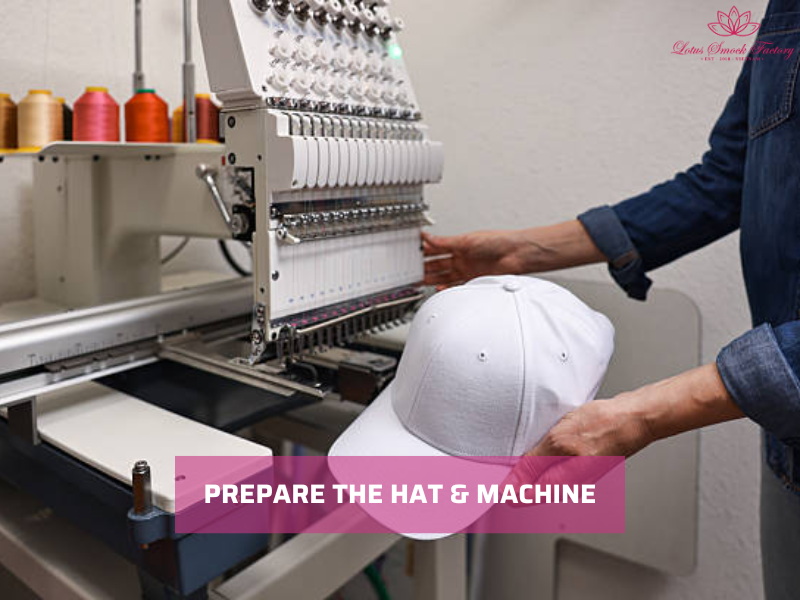
5.2. Step 2: Add Stabiliser
Stabilisers support the fabric and prevent puckering while the machine stitches.
- For beanies or knit hats, use a cut-away stabiliser. Place it inside the crown of the hat and make sure it covers the full design area.
- For baseball caps or structured hats, use a tear-away stabiliser under the hoop or crown. This type is removed after stitching.
Note: You should cut a stabiliser square larger than the design; about 20 x 20 cm works for most hats. This gives enough support around the edges.
5.3. Step 3: Embroider the Design
Now you can start stitching.
- Adjust settings: Set the speed of your machine to medium. Too fast may cause fabric shifting or broken needles. You adjust stitch length to match the design.
- Secure the hat: Make sure the hoop or stabiliser keeps the hat tight. If the fabric shifts, the design may distort.
- Test stitches: Always run a test on scrap fabric or an old hat first. This lets you check thread tension, colour, and design placement.
- Start embroidery: Follow the machine’s programmed pattern. Stay near the machine while it works to stop it if the thread tangles or fabric puckers.
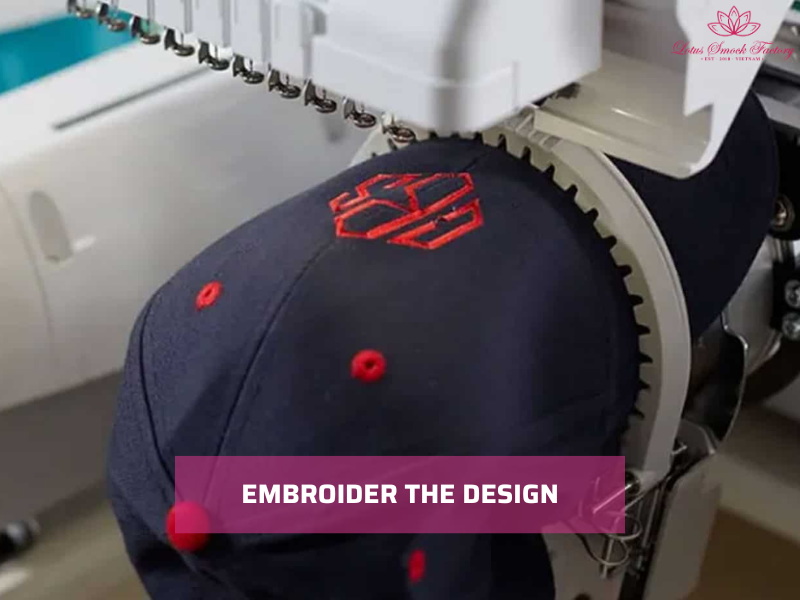
5.4. Step 4: Clean Up & Finish
When the design is complete, remove the hat from the hoop carefully.
- Remove stabiliser: Tear away excess stabiliser from structured hats or trim cut-away stabiliser close to the stitches on knit hats.
- Tidy threads: Trim any loose threads with small scissors. Check both front and inside of the hat.
- Press lightly: Place the hat face down on a towel and press the embroidered area gently with a warm iron. Use a cloth barrier between the iron and stitches. This keeps the embroidery smooth without flattening it.
With these steps, you can create clean, durable designs on hats using a machine. Start with simple patterns like monograms or logos before moving to larger or detailed designs.
6. Common Mistakes in Hat Embroidery (And How to Fix Them)
When learning how to embroider hats, beginners often face problems with fabric, thread, or placement. Below are the most common issues and how to solve them.
Puckering fabric
Hats have curved surfaces and thick seams that make fabric shift. Puckering happens when the fabric is not supported well.
⇒ Fix it by using the correct stabiliser for your hat type. You cut-away stabiliser works best for knit beanies, while the tear-away stabiliser suits structured caps. After that, you adjust the hoop tension so the fabric is firm but not overstretched.
Design off-center
Crooked or misplaced designs make the hat look unprofessional. This happens when you stitch without accurate measurements.
⇒ Fix it by marking the design area before stitching. You use chalk or a water-soluble pen to outline the exact spot. Measure from seams or edges to check balance before you begin.
Thread tangling
The thread can twist, knot, or fray, especially when pulled through thick fabric layers. Tangling interrupts stitching and weakens the design.
⇒ You use shorter thread lengths (30–40 cm) for hand embroidery and high-quality polyester thread for machine work. Let the thread relax often to reduce twisting.
Tangling interrupts stitching and weakens the design
Needle breaking
Needles may snap when pushed through dense seams or heavy fabrics. Using the wrong needle type makes this worse.
⇒ To fix it, you switch to heavy-duty needles. For hand embroidery, use sharp embroidery needles (sizes 5–7). For machines, use denim or ballpoint needles depending on the hat fabric.
Expert Tip: Always test your embroidery on an old hat or scrap fabric first. Testing lets you adjust thread tension, stabiliser, and design placement before you stitch on the final piece.
7. Creative Embroidery Design Ideas for Hats
Once you know how to embroider hats, the next step is choosing designs that suit your style or purpose. Here are some ideas to help you get started.
Monograms & Initials
Monograms are classic and easy to stitch. They look sharp on baseball caps and beanies. A single letter on the front panel, or small initials on the side, gives a personalised touch. You should use backstitch for outlines or satin stitch for bold letters. Monogrammed hats also make great gifts and are popular for boutique sellers.
Floral Embroidery
Floral designs add colour and softness to hats. You can embroider small flowers on the brim of a bucket hat or along the edge of a beanie. For caps, floral motifs work well on the side panels. Daisies, roses, or vines make simple yet eye-catching choices.
If you want to learn more about stitching flowers, see our guide on how to embroider flowers.
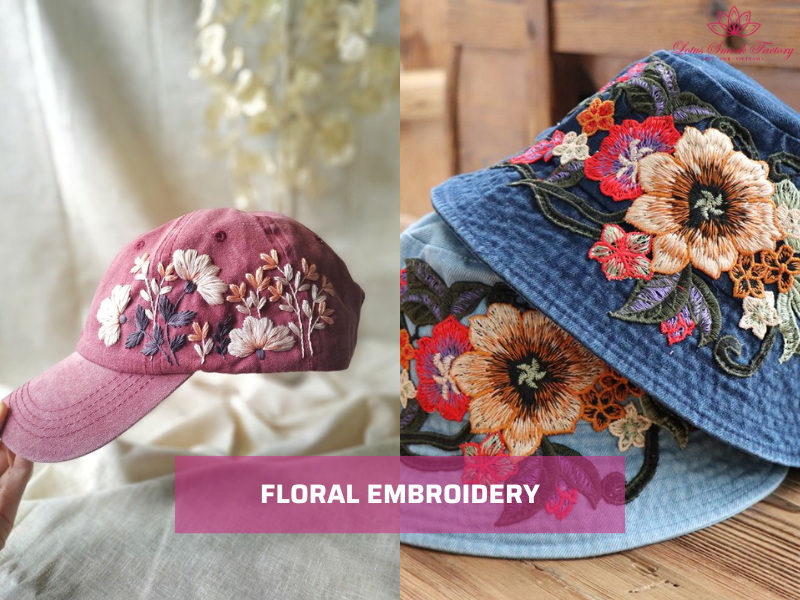
Seasonal & Fashion Projects
Seasonal designs make hats more versatile. You can stitch snowflakes or Christmas trees on festive beanies, add decorative borders to sunhats, or try bold patterns on denim bucket hats. These projects are great for fashion-focused embroidery and give you endless ways to update your wardrobe.
For more inspiration with denim fabric, check our tutorial on how to embroider on denim.
8. FAQs
8.1. Can you embroider a hat without a hoop?
Yes. You can embroider hats without a hoop, especially structured caps where hoops don’t fit well. In this case, use a stabiliser to keep the fabric firm and hold it taut with your hand. For beanies or bucket hats, a small hoop (10–12 cm) gives better results.
8.2. What type of hat is easiest to embroider?
Beanies and bucket hats are easier for beginners. They have softer, flatter areas that fit into hoops. Baseball caps are more challenging because of the curved crown and stiff seams, but they are still manageable with stabiliser and careful placement.
8.3. Do you need stabiliser for every design?
Yes, stabiliser is recommended for almost all hat embroidery. It prevents puckering, stretching, and shifting during stitching. Use cut-away stabiliser for stretchy hats like beanies and tear-away stabiliser for structured caps. Without stabiliser, designs often look uneven and may not last.
8.4. How durable is embroidery on hats after washing?
Embroidery on hats is durable if you use quality thread and secure knots. Hand wash or use a gentle machine cycle in a mesh bag. Air dry flat to prevent shrinking. With proper care, embroidery can last for years without fading or loosening.
8.5. Can beginners embroider hats by hand?
Yes. Beginners can embroider hats by hand with basic stitches like backstitch, satin stitch, and French knots. Start with small designs on the side of a beanie or cuff before moving to larger, more complex designs on the crown of a cap.
9. Final Words
Now you know the basics of how to embroider hats and why it is a simple way to personalise fashion. With a few tools and easy stitches, you can turn a plain cap, beanie, or bucket hat into something unique. Start small on a cuff or side panel, then move to larger areas once you feel confident.
Remember to use the right stabiliser and keep your design centered. Pick up a hat, choose your thread, and begin today. Your embroidered hats will carry both style and meaning.
Lotus Smock is a brand of TAQ SERVICE TRADING DEVELOPMENT JSC. In clothing business, we’ve been crafting unique pieces for the domestic market since 2010. We prioritize the quality, so we don’t accept overly big orders. We are committed to producing high-quality products at the best prices. Recently, we have started engaging in social media and marketing to reach international customers, bringing the best products from Vietnam to friends around the world.
Contact Lotus Smock at:
- Facebook: facebook.com/lotussmockfactory
- WhatsApp: +84 83 333 3498
- Youtube: youtube.com/@LotusSmockFactory
